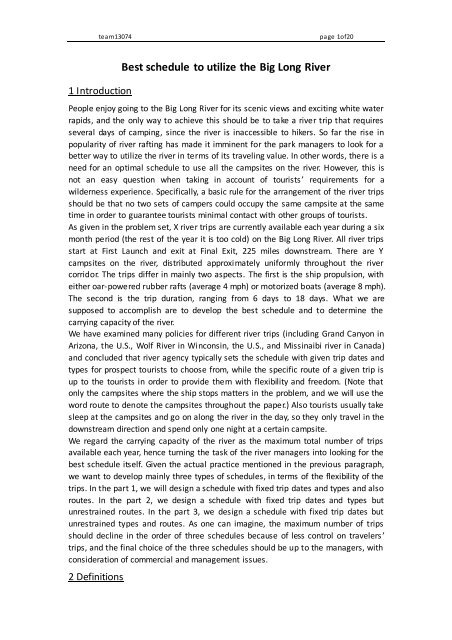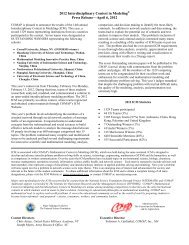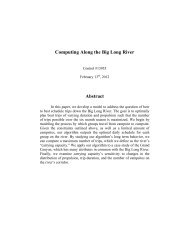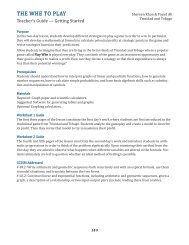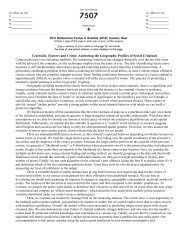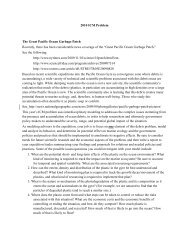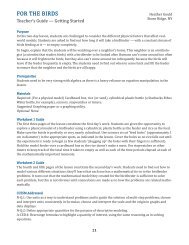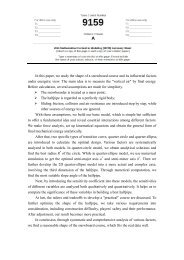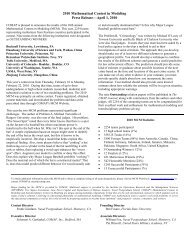Team 13074: Best schedule to utilize the Big Long River
Team 13074: Best schedule to utilize the Big Long River
Team 13074: Best schedule to utilize the Big Long River
Create successful ePaper yourself
Turn your PDF publications into a flip-book with our unique Google optimized e-Paper software.
team<strong>13074</strong><br />
page 1of20<br />
1 Introduction<br />
<strong>Best</strong> <strong>schedule</strong> <strong>to</strong> <strong>utilize</strong> <strong>the</strong> <strong>Big</strong> <strong>Long</strong> <strong>River</strong><br />
People enjoy going <strong>to</strong> <strong>the</strong> <strong>Big</strong> <strong>Long</strong> <strong>River</strong> for its scenic views and exciting white water<br />
rapids, and <strong>the</strong> only way <strong>to</strong> achieve this should be <strong>to</strong> take a river trip that requires<br />
several days of camping, since <strong>the</strong> river is inaccessible <strong>to</strong> hikers. So far <strong>the</strong> rise in<br />
popularity of river rafting has made it imminent for <strong>the</strong> park managers <strong>to</strong> look for a<br />
better way <strong>to</strong> <strong>utilize</strong> <strong>the</strong> river in terms of its traveling value. In o<strong>the</strong>r words, <strong>the</strong>re is a<br />
need for an optimal <strong>schedule</strong> <strong>to</strong> use all <strong>the</strong> campsites on <strong>the</strong> river. However, this is<br />
not an easy question when taking in account of <strong>to</strong>urists’ requirements for a<br />
wilderness experience. Specifically, a basic rule for <strong>the</strong> arrangement of <strong>the</strong> river trips<br />
should be that no two sets of campers could occupy <strong>the</strong> same campsite at <strong>the</strong> same<br />
time in order <strong>to</strong> guarantee <strong>to</strong>urists minimal contact with o<strong>the</strong>r groups of <strong>to</strong>urists.<br />
As given in <strong>the</strong> problem set, X river trips are currently available each year during a six<br />
month period (<strong>the</strong> rest of <strong>the</strong> year it is <strong>to</strong>o cold) on <strong>the</strong> <strong>Big</strong> <strong>Long</strong> <strong>River</strong>. All river trips<br />
start at First Launch and exit at Final Exit, 225 miles downstream. There are Y<br />
campsites on <strong>the</strong> river, distributed approximately uniformly throughout <strong>the</strong> river<br />
corridor. The trips differ in mainly two aspects. The first is <strong>the</strong> ship propulsion, with<br />
ei<strong>the</strong>r oar-powered rubber rafts (average 4 mph) or mo<strong>to</strong>rized boats (average 8 mph).<br />
The second is <strong>the</strong> trip duration, ranging from 6 days <strong>to</strong> 18 days. What we are<br />
supposed <strong>to</strong> accomplish are <strong>to</strong> develop <strong>the</strong> best <strong>schedule</strong> and <strong>to</strong> determine <strong>the</strong><br />
carrying capacity of <strong>the</strong> river.<br />
We have examined many policies for different river trips (including Grand Canyon in<br />
Arizona, <strong>the</strong> U.S., Wolf <strong>River</strong> in Winconsin, <strong>the</strong> U.S., and Missinaibi river in Canada)<br />
and concluded that river agency typically sets <strong>the</strong> <strong>schedule</strong> with given trip dates and<br />
types for prospect <strong>to</strong>urists <strong>to</strong> choose from, while <strong>the</strong> specific route of a given trip is<br />
up <strong>to</strong> <strong>the</strong> <strong>to</strong>urists in order <strong>to</strong> provide <strong>the</strong>m with flexibility and freedom. (Note that<br />
only <strong>the</strong> campsites where <strong>the</strong> ship s<strong>to</strong>ps matters in <strong>the</strong> problem, and we will use <strong>the</strong><br />
word route <strong>to</strong> denote <strong>the</strong> campsites throughout <strong>the</strong> paper.) Also <strong>to</strong>urists usually take<br />
sleep at <strong>the</strong> campsites and go on along <strong>the</strong> river in <strong>the</strong> day, so <strong>the</strong>y only travel in <strong>the</strong><br />
downstream direction and spend only one night at a certain campsite.<br />
We regard <strong>the</strong> carrying capacity of <strong>the</strong> river as <strong>the</strong> maximum <strong>to</strong>tal number of trips<br />
available each year, hence turning <strong>the</strong> task of <strong>the</strong> river managers in<strong>to</strong> looking for <strong>the</strong><br />
best <strong>schedule</strong> itself. Given <strong>the</strong> actual practice mentioned in <strong>the</strong> previous paragraph,<br />
we want <strong>to</strong> develop mainly three types of <strong>schedule</strong>s, in terms of <strong>the</strong> flexibility of <strong>the</strong><br />
trips. In <strong>the</strong> part 1, we will design a <strong>schedule</strong> with fixed trip dates and types and also<br />
routes. In <strong>the</strong> part 2, we design a <strong>schedule</strong> with fixed trip dates and types but<br />
unrestrained routes. In <strong>the</strong> part 3, we design a <strong>schedule</strong> with fixed trip dates but<br />
unrestrained types and routes. As one can imagine, <strong>the</strong> maximum number of trips<br />
should decline in <strong>the</strong> order of three <strong>schedule</strong>s because of less control on travelers ’<br />
trips, and <strong>the</strong> final choice of <strong>the</strong> three <strong>schedule</strong>s should be up <strong>to</strong> <strong>the</strong> managers, with<br />
consideration of commercial and management issues.<br />
2 Definitions
team<strong>13074</strong><br />
page 2of20<br />
(1) “optimal”: it means <strong>to</strong> best <strong>utilize</strong> all <strong>the</strong> campsites and maximize <strong>the</strong> <strong>to</strong>tal<br />
number of trips in a six months period.<br />
(2) “route”: it means <strong>the</strong> campsites at which <strong>to</strong>urists choose <strong>to</strong> s<strong>to</strong>p in a given trip.<br />
(3) “orbit”: it means a specific campsite set that allows some certain trip types <strong>to</strong><br />
travel in.<br />
(4) For better description we assign a natural number <strong>to</strong> every campsite in <strong>the</strong><br />
downstream direction, from 0 <strong>to</strong> Y+1.<br />
(5) For better description we assign a natural number <strong>to</strong> every trip type, from 1 <strong>to</strong> 26,<br />
as shown in <strong>the</strong> following chart.<br />
6 7 8 9 10 11 12 13 14 15 16 17 18<br />
Oar-powered 1 3 5 7 9 11 13 15 17 19 21 23 25<br />
Mo<strong>to</strong>rized 2 4 6 8 10 12 14 16 18 20 22 24 26<br />
Chart1 The numbered list of trip types<br />
(6) We use A i <strong>to</strong> denote <strong>the</strong> average time <strong>to</strong>urists travel per day for a certain trip<br />
type i.<br />
(7) We use n i <strong>to</strong> denote <strong>the</strong> number of campsites in every orbit corresponding <strong>to</strong><br />
trip type i.<br />
(8) We use m i <strong>to</strong> denote <strong>the</strong> number of trips in a six months period for a certain<br />
trip type i.<br />
3 Specific formulation of problem<br />
We denote <strong>the</strong> river and <strong>the</strong> campsites along it using a straight segment with Y<br />
uniformly distributed points in it. Time is measured in day units. The <strong>to</strong>tal time<br />
period is 180 days (six months). Passengers choose <strong>to</strong> stay at a different point every<br />
day downstream <strong>the</strong> segment. Here our paper will focus on three sub questions.<br />
In part 1, passengers have <strong>to</strong> travel along <strong>the</strong> rigid route set by river agency, so <strong>the</strong><br />
problem should be <strong>to</strong> come up with <strong>the</strong> <strong>schedule</strong> <strong>to</strong> arrange for <strong>the</strong> maximum<br />
number of trips without occurrence of two different trips occupying <strong>the</strong> same<br />
campsite on <strong>the</strong> same day.<br />
In part 2, passengers have <strong>the</strong> freedom <strong>to</strong> choose which campsites <strong>to</strong> s<strong>to</strong>p at,<br />
<strong>the</strong>refore <strong>the</strong> ma<strong>the</strong>matical description of <strong>the</strong>ir actions inevitably involve<br />
randomness and probability, and we actually use a probability model. The next<br />
campsite passengers choose at a current given campsite is subject <strong>to</strong> a certain<br />
distribution, and we describe events of two trips occupying <strong>the</strong> same campsite by<br />
probability. Note in probability model it is no longer appropriate <strong>to</strong> say that two tri ps<br />
do not meet at a campsite with certainty; instead, we regard events as impossible if<br />
<strong>the</strong>ir probabilities are below an adequately small number. Then we try <strong>to</strong> find <strong>the</strong><br />
optimal <strong>schedule</strong>.<br />
In part 3, passengers have <strong>the</strong> freedom <strong>to</strong> choose both <strong>the</strong> type and route of <strong>the</strong> trip;<br />
<strong>the</strong>refore a probability model is also necessary. We continue <strong>to</strong> adopt <strong>the</strong> probability<br />
description as in part 2 and <strong>the</strong>n try <strong>to</strong> find <strong>the</strong> optimal <strong>schedule</strong>.<br />
4 Assumptions<br />
We make following assumptions:
team<strong>13074</strong><br />
page 3of20<br />
1Passengers may not travel back <strong>to</strong> previous campsite, namely <strong>the</strong>y can only go in<br />
downstream direction.<br />
2Passengers can only stay at a certain campsite for one day.<br />
3Time is measured in day units and <strong>the</strong> time traveling from one campsite <strong>to</strong><br />
ano<strong>the</strong>r should always be less than 24 hours (one day) since passengers need <strong>to</strong><br />
settle at a campsite every night.<br />
4Passengers typically spend half of a day on <strong>the</strong> river everyday and according <strong>to</strong><br />
reference we arbitrarily set <strong>the</strong> time passengers can travel on <strong>the</strong> river is 8 hours per<br />
day.<br />
5In part 2 and part 3, we need <strong>to</strong> assign <strong>the</strong> route of a given trip with a probability<br />
distribution, and we assume it is classical probability, which means all possible routes<br />
for a certain trip share <strong>the</strong> same probability.<br />
In fact, this assumption is reasonable not only because <strong>the</strong> classical probability can<br />
be accepted in reality, but also that it is convenient <strong>to</strong> replace with o<strong>the</strong>r given<br />
distributions and <strong>the</strong> model still works in <strong>the</strong> same way. In terms of simplification,<br />
however, we only use <strong>the</strong> classical probability in part 2 and part 3 <strong>to</strong> demonstrate our<br />
model.<br />
6As we need <strong>to</strong> define <strong>the</strong> happening of <strong>the</strong> event of two trips occupying <strong>the</strong> same<br />
campsite in part 2 and part 3, we choose <strong>the</strong> standard widely used in Probability and<br />
Statistics that a small probability event can be considered as not happening in <strong>the</strong><br />
s<strong>to</strong>chastic sense. Specifically, we choose <strong>the</strong> small probability <strong>to</strong> be below 0.05,<br />
0.025.<br />
7As Y is given in <strong>the</strong> problem, our <strong>schedule</strong> need <strong>to</strong> be feasible for different values<br />
of Y. In terms of simplicity, we let Y=150 when precise calculation is needed <strong>to</strong> fur<strong>the</strong>r<br />
illustrate <strong>the</strong> model. (According <strong>to</strong> <strong>the</strong> reference, we choose <strong>the</strong> number of<br />
campsites in Grand Canyon in Arizona, namely 150, for <strong>the</strong> approximate value of Y,<br />
since <strong>the</strong> length of <strong>the</strong> Grand Canyon <strong>River</strong> is also 225 miles which is compatible with<br />
<strong>the</strong> <strong>Big</strong> <strong>Long</strong> <strong>River</strong> in <strong>the</strong> problem.)<br />
5 Part 1 <strong>Best</strong> <strong>schedule</strong> of trips with fixed dates, types and also routes.<br />
5.1 Method<br />
5.1.1 Motivation and justification<br />
Although most river agencies do not use fixed trip routes <strong>to</strong> passengers in order <strong>to</strong><br />
provide with more flexibility, <strong>the</strong>re is still necessity <strong>to</strong> first discuss <strong>the</strong> <strong>schedule</strong> if trip<br />
dates, types and routes are all fixed by river agency, since less flexibility for<br />
passengers allow more possible space <strong>to</strong> arrange trips. Therefore we expect this kind<br />
of <strong>schedule</strong> <strong>to</strong> achieve <strong>the</strong> highest number of river trips.<br />
The special assumptions for this part are ra<strong>the</strong>r self-explana<strong>to</strong>ry. Passengers need <strong>to</strong><br />
obey <strong>the</strong> trip dates, types and routes prescribed by <strong>the</strong> river agency.<br />
5.1.2 Key ideas<br />
To best <strong>utilize</strong> <strong>the</strong> campsites on <strong>the</strong> river, it is obvious that we should minimize <strong>the</strong><br />
<strong>to</strong>tal number of days of all campsites when no ship occupying <strong>the</strong>m. In o<strong>the</strong>r word,<br />
we are <strong>to</strong> use <strong>the</strong> trips <strong>to</strong> occupy as many campsites as possible as long as no two
team<strong>13074</strong><br />
page 4of20<br />
trips occupy <strong>the</strong> same campsite at <strong>the</strong> same day. We divide <strong>the</strong> <strong>schedule</strong> problem<br />
in<strong>to</strong> three subparts. First (see 5.2.1) we assign a specific set of campsites <strong>to</strong> every<br />
type of trips and no two different campsite sets intersect, <strong>the</strong>n we only need <strong>to</strong> find<br />
<strong>the</strong> best <strong>schedule</strong> of every type of trip within corresponding campsite set. Second<br />
(see 5.2.2) we discuss <strong>the</strong> situation where Y is relatively small, and we continue <strong>the</strong><br />
idea by assigning a specific campsite set <strong>to</strong> every group of trip types. The <strong>schedule</strong>s<br />
for <strong>the</strong> situations where one group contains two and three trip types are given<br />
respectively. Third (see 5.2.3) we fur<strong>the</strong>r develop <strong>the</strong> idea <strong>to</strong> only divide in<strong>to</strong> two<br />
campsite sets for <strong>the</strong> case when Y is very small. Finally we finish <strong>the</strong> discussion of<br />
best <strong>schedule</strong> for different values of Y and come up with an exact <strong>schedule</strong> when<br />
Y=150 in 5.2.2.<br />
Chart2 brief description of <strong>the</strong> model<br />
Note for brief description of <strong>the</strong> model, we will denote every specific campsite set<br />
with <strong>the</strong> word “orbit” throughout <strong>the</strong> paper.<br />
5.2 Development of <strong>the</strong> model<br />
To begin with, we find out <strong>the</strong> number of trip types available.<br />
As for every trip type i, we calculate <strong>the</strong> average time needed for driving <strong>the</strong> ship per<br />
day and denote it withA i . According <strong>to</strong> assumption 4.4 (Passengers drive <strong>the</strong> ship<br />
at most 8 hours a day), <strong>the</strong> trip type is possible iff A i ≤ 8. Therefore trip type 1<br />
(oar-powered, 6 days) and trip type 3 (oar-powered, 7 days) are crossed out. But<br />
here we allow <strong>the</strong> trip type 3 in <strong>the</strong> <strong>schedule</strong> <strong>to</strong> maximize <strong>the</strong> <strong>to</strong>tal number of trips,<br />
since A 3 = 225<br />
= 8.03 is really close <strong>to</strong> 8.<br />
4∗7<br />
Consequently <strong>the</strong>re are al<strong>to</strong>ge<strong>the</strong>r 25 trip types available.<br />
5.2.1 Every campsite set for every single trip type<br />
We will discuss <strong>the</strong> situation where Y is big enough here.<br />
(ⅰ)Dividing in<strong>to</strong> separate campsite sets<br />
We now have 25 trip types and we assign <strong>the</strong>m with campsite sets using a ra<strong>the</strong>r<br />
simple way. Put <strong>the</strong> campsites whose remainders divided by 25 are <strong>the</strong> same in<strong>to</strong><br />
one campsite set and sequentially assign <strong>the</strong> 25 campsite sets <strong>to</strong> 25 trip types.<br />
Therefore every campsite set contains<br />
Y<br />
25 campsites.<br />
As we can see from <strong>the</strong> chart below, <strong>the</strong> distance between two adjacent campsites in
team<strong>13074</strong><br />
page 5of20<br />
a specific orbit is less than <strong>the</strong> length of what we call an interval = ( 25 Y ∗ 225)miles.<br />
(ⅱ)<strong>Best</strong> <strong>schedule</strong> for a certain campsite set<br />
There are al<strong>to</strong>ge<strong>the</strong>r 25 orbits and we are going <strong>to</strong> demonstrate <strong>the</strong> <strong>schedule</strong> of orbit<br />
for trip type 3 only, since <strong>the</strong> <strong>schedule</strong>s of o<strong>the</strong>r orbits are ra<strong>the</strong>r similar with <strong>the</strong><br />
entirely identical designing idea.<br />
Now that for trip type 3, we first calculate <strong>the</strong> maximum number of intervals<br />
(denoted by Q) that <strong>the</strong> trip can cover in a day. Passengers can row <strong>the</strong> boat at most<br />
8 hours per day and trip type 3 travels at <strong>the</strong> velocity of 4 mph, so trip type 3 travels<br />
8 ∗ 4 = 32miles per day. ThereforeQ = [ 32∗Y<br />
25∗225 ].<br />
Now consider <strong>the</strong> best <strong>schedule</strong>. To best <strong>utilize</strong> all campsites means <strong>to</strong> minimize <strong>the</strong><br />
number of <strong>to</strong>tal days of empty campsites. We call <strong>the</strong> very first trip that ever comes<br />
in<strong>to</strong> <strong>the</strong> river “leader”, and apparently <strong>the</strong> campsites are by no means occupied if<br />
<strong>the</strong>y cannot be reached by <strong>the</strong> “leader” traveling in <strong>the</strong> fastest way possible. We call<br />
<strong>the</strong>se campsites “forgone loss” for <strong>the</strong> time being. Therefore if we come up with a<br />
<strong>schedule</strong> that occupied every campsite every day except <strong>the</strong>se “forgone loss”, <strong>the</strong>n it<br />
must be <strong>the</strong> best <strong>schedule</strong>. As for minimizing <strong>the</strong> number of “forgone loss”, <strong>the</strong><br />
“leader” should travel Q every day from <strong>the</strong> beginning until it cannot. For every day<br />
we let Q trips come in<strong>to</strong> <strong>the</strong> river <strong>to</strong> occupy all of <strong>the</strong> campsites in front of <strong>the</strong><br />
leader’s campsite and <strong>the</strong>y just copy <strong>the</strong> leader’s route and get <strong>to</strong> Final Exit <strong>the</strong> same<br />
day with “leader”. For only several days <strong>the</strong> arrangement forms a cycle and <strong>the</strong><br />
<strong>schedule</strong> just continues <strong>to</strong> copy <strong>the</strong> cycle.<br />
Start → Q → 2Q → ⋯ → z Q Q → z Q Q + (Q − 1) → z Q Q + 2(Q − 1) → ⋯<br />
Q<br />
Q<br />
Q<br />
→ z Q Q + z Q−1 (Q − 1) → ⋯ → ∑ z i i + 1 → ∑ z i i + 2 → ⋯ → ∑ z i i → end<br />
i=2<br />
i=2<br />
i=1<br />
where<br />
Q<br />
∑ z i i = n i<br />
i=1<br />
Q<br />
Q<br />
∑z i = duration − 1<br />
i=1<br />
Q<br />
j−1<br />
∑ z i i + j + (duration − 2 − ∑ z i ) > ∑ z i i<br />
j = 2,3, ⋯ , Q<br />
i=j<br />
i=j<br />
In case of being confused by our awkward description, see <strong>the</strong> following illustration<br />
of <strong>the</strong> <strong>schedule</strong> where Y=425 as an example.<br />
i=1
team<strong>13074</strong><br />
page 6of20<br />
Chart3 Schedule where Y=425<br />
(ⅲ)Arrangement of separate campsite sets if <strong>the</strong> proportions of all trip types are<br />
given<br />
As shown above in chart3, <strong>the</strong> number of “forgone loss” can be ignored compared<br />
with <strong>the</strong> <strong>to</strong>tal number of days available of all campsites, namely180 ∗ Y. In o<strong>the</strong>r<br />
word, <strong>the</strong> <strong>schedule</strong> enables <strong>the</strong> trips <strong>to</strong> occupy nearly all campsites for all days in a<br />
six months period, and obviously it can be regarded as <strong>the</strong> best s chedule.<br />
Fur<strong>the</strong>rmore, if we ignore <strong>the</strong> “forgone loss” and <strong>the</strong> <strong>to</strong>tal number of a specific trip<br />
180∗n i<br />
type i can be calculated asm i = [<br />
]. Therefore n duration of type i ican be determined<br />
by m i .<br />
We can now design a <strong>schedule</strong> with given proportions of all trip types. This is<br />
because:<br />
Given proportions of all trip types→<strong>the</strong> ratio of <strong>the</strong> <strong>to</strong>tal number of any two trip<br />
types m i<br />
m j<br />
→<strong>the</strong> ratio of <strong>the</strong> campsites n i<br />
n j<br />
→combine with ∑ i n i = Y → n i<br />
(Note this makes sense because <strong>the</strong> river agency is supposed <strong>to</strong> provide with a<br />
variety of trip types and <strong>the</strong> flexibility <strong>to</strong> control <strong>the</strong> proportions of all trip types is<br />
even more meaningful, since <strong>the</strong> river agency can refer <strong>to</strong> his<strong>to</strong>rical data and design a<br />
<strong>schedule</strong> with proportions of all trip types compatible with previous demands of<br />
<strong>to</strong>urists.)<br />
Therefore we only need <strong>to</strong> design a <strong>schedule</strong> <strong>to</strong> allocate all Y campsites <strong>to</strong> n i orbits<br />
respectively.
team<strong>13074</strong><br />
page 7of20<br />
Apparently an orbit in which <strong>the</strong> trip type can travel between any two adjacent<br />
campsites in a day can accommodates with a <strong>schedule</strong> similar <strong>to</strong> (ⅱ). Here <strong>the</strong><br />
“leader” still travels in <strong>the</strong> fastest way every day and o<strong>the</strong>r trips follow <strong>the</strong> “leader”<br />
occupy all campsites in front of <strong>the</strong> leader’s campsite, and this <strong>schedule</strong> makes<br />
nearly all campsites occupied every day throughout <strong>the</strong> six months period.<br />
Now we only need an allocation satisfying that for every orbit <strong>the</strong> trip type can travel<br />
between any two adjacent campsites in a day. Note for a subset of orbit, if <strong>the</strong> trip<br />
can already travel between any two adjacent campsites in it, <strong>the</strong>n <strong>the</strong> trip must be<br />
able <strong>to</strong> travel between any two adjacent campsites in <strong>the</strong> whole orbit. Call this subset<br />
a “skele<strong>to</strong>n orbit” and we only need <strong>to</strong> find <strong>the</strong> allocation of skele<strong>to</strong>n orbits now.<br />
Consider <strong>the</strong> trip types in <strong>the</strong> order from <strong>the</strong> maximum A i <strong>to</strong> <strong>the</strong> minimumA i .<br />
AsminA i = A 3 , we consider trip type 3 first. Apparently <strong>the</strong> following six campsites<br />
constitute <strong>the</strong> skele<strong>to</strong>n orbit of trip type 3, as shown in <strong>the</strong> chart:<br />
Chart4 Skele<strong>to</strong>n orbit of trip type3<br />
SinceA i ≥ A 3 , for any trip type i, it can also travel <strong>the</strong> distance of two adjacent<br />
campsites in <strong>the</strong> skele<strong>to</strong>n orbit of type 3 in a day, so seven campsites (k, (Y+1)<br />
+<br />
k, 2(Y+1)<br />
7<br />
+ k, 3(Y+1)<br />
7<br />
+ k, 4(Y+1)<br />
7<br />
+ k, 5(Y+1)<br />
7<br />
<strong>the</strong> skele<strong>to</strong>n orbit of type i, as shown in chart:<br />
+ k, 6(Y+1)<br />
7<br />
+ k, k = 1,2,… 2 ) constitute<br />
7<br />
Chart5 skele<strong>to</strong>n orbit of typei<br />
As long as n i ≥ 7 holds for all I, o<strong>the</strong>r (n i − 7)campsites can be chosen casually<br />
and finally we have <strong>the</strong> allocation needed.<br />
The <strong>schedule</strong> here need a basic condition thatY ≥ 7 + ⋯ + 18 + 6 + 7 + ⋯ + 18 =<br />
306.<br />
5.2.2 Every campsite set for every multiple trip types<br />
WhenY < 306, <strong>the</strong> above <strong>schedule</strong> becomes invalid. We now consider <strong>the</strong> allocation<br />
where one orbit is for multiple trip types. For simplicity we consider <strong>the</strong> case where<br />
any one orbit contains trip types of <strong>the</strong> same ship propulsion.<br />
For instance, consider <strong>the</strong> allocation of 13 orbits for 13 groups of trip types as below<br />
(<strong>the</strong> numbers denote <strong>the</strong> duration of <strong>the</strong> trip type):<br />
Oar-powered ships(7,8),(9,10),(11,12),(13,14),(15,16),(17,18)<br />
Mo<strong>to</strong>rized ships(6),(7,8),(9,10),(11,12),(13,14),(15,16),(17,18)<br />
We only demonstrate <strong>the</strong> <strong>schedule</strong> for <strong>the</strong> group (7,8) of oar-powered ships, since<br />
<strong>the</strong> <strong>schedule</strong> for o<strong>the</strong>r groups are similar.<br />
The <strong>schedule</strong> is shown below in <strong>the</strong> same way as in 5.2.1:
team<strong>13074</strong><br />
page 8of20<br />
Chart6 <strong>schedule</strong> when <strong>the</strong> campsite set is for 2 trip types<br />
As one can see, <strong>the</strong> ratio of <strong>the</strong> two trip types can also be any number differing from<br />
2<br />
1<br />
shown in <strong>the</strong> above example. To achieve this we only need <strong>to</strong> replace <strong>the</strong> (7,7,8) in<br />
<strong>the</strong> above <strong>schedule</strong> with o<strong>the</strong>r combination of <strong>the</strong> two trip types. Therefore similar<br />
<strong>to</strong> 5.2.1, we are able <strong>to</strong> design <strong>the</strong> <strong>schedule</strong> for given proportions of all trip types by<br />
designing <strong>the</strong> <strong>schedule</strong> for corresponding ratio of every two trip types of <strong>the</strong> same<br />
group.<br />
As mentioned in assumption 47, we calculate for <strong>the</strong> exact <strong>schedule</strong> when Y=150 in<br />
order <strong>to</strong> illustrate <strong>the</strong> model. For simplicity we let different trip types distribute<br />
uniformly.<br />
Similar with 5.2.1, in order <strong>to</strong> make sure every trip can achieve its duration, we need<br />
Y ≥ 5 + 2(7 + 9 + 11 + 13 + 15 + 17) = 149. As Y=150, a certain trip can cover at<br />
most 2 intervals each day, and for most time, a certain trip can only cover 1 interval.<br />
Therefore, similar with 5.2.1, we can find out that only 2 days form a cycle. We only<br />
present two days’ <strong>schedule</strong>, and <strong>the</strong> following days’ <strong>schedule</strong> can copy <strong>the</strong> cycle.
team<strong>13074</strong><br />
page 9of20<br />
date Trip types Trip routes<br />
1<br />
2<br />
O-7 21, 42, 63, 84, 105, 126<br />
O-9 2, 20, 41, 62, 83, 104, 108, 125<br />
O-11 6, 19, 28, 40, 61, 66, 82, 103, 112, 124<br />
O-13 4, 18, 39, 47, 59, 71, 81, 102, 107, 123, 130, 144<br />
O-15 1, 9, 17, 25, 38, 44, 58, 65, 70, 80, 91, 101, 111, 122<br />
O-17 16, 23, 37, 49, 57, 72, 79, 87, 93, 100, 109, 113, 121, 128, 135, 142<br />
M-6 30, 60, 90, 120, 134<br />
M-7 15, 36, 56, 78, 99, 119<br />
M-9 14, 22, 35, 55, 69, 77, 98, 118<br />
M-11 13, 34, 43, 54, 64, 68, 76, 97, 106, 117<br />
M-13 7, 12, 33, 45, 53, 67, 75, 96, 110, 116, 129, 133<br />
M-15 3, 8, 11, 24, 32, 46, 52, 74, 85, 89, 95, 115, 127, 132<br />
M-17 5, 10, 26, 27, 29, 31, 48, 50, 51, 73, 86, 88, 92, 94, 114, 131<br />
O-8 21, 42, 63, 84, 105, 126, 147<br />
O-10 2, 20, 41, 62, 83, 104, 108, 125, 146<br />
O-12 6, 19, 28, 40, 61, 66, 82, 103, 112, 124, 145<br />
O-14 4, 18, 39, 47, 59, 71, 81, 102, 107, 123, 130, 144, 149<br />
O-16 1, 9, 17, 25, 38, 44, 58, 65, 70, 80, 91, 101, 111, 122, 143<br />
O-18 16, 23, 37, 49, 57, 72, 79, 87, 93, 100, 109, 113, 121, 128, 135, 142, 148<br />
M-6 30, 60, 90, 120, 134<br />
M-8 15, 36, 56, 78, 99, 119, 141<br />
M-10 14, 22, 35, 55, 69, 77, 98, 118, 140<br />
M-12 13, 34, 43, 54, 64, 68, 76, 97, 106, 117, 139<br />
M-14 7, 12, 33, 45, 53, 67, 75, 96, 110, 116, 129, 133, 138<br />
M-16 3, 8, 11, 24, 32, 46, 52, 74, 85, 89, 95, 115, 127, 132, 137<br />
M-18 5, 10, 26, 27, 29, 31, 48, 50, 51, 73, 86, 88, 92, 94, 114, 131, 136<br />
Chart7 The first two days’ <strong>schedule</strong><br />
In <strong>the</strong> chart above, in <strong>the</strong> sign “I j-k”, I stands for <strong>the</strong> number of <strong>the</strong> certain trip type,<br />
and j stands for <strong>the</strong> propulsion which O for oar-powered and M for mo<strong>to</strong>rized, and k<br />
stands for <strong>the</strong> duration. For example, “3 M-6s” stands for 3 6-night trips of mo<strong>to</strong>rized<br />
boat.<br />
The carrying capacity of <strong>the</strong> river based on <strong>the</strong> <strong>schedule</strong> above is 26×180<br />
= 2340.<br />
5.2.3 One campsite set for all trip types<br />
When Y continues <strong>to</strong> decline, it is easy <strong>to</strong> fur<strong>the</strong>r develop <strong>the</strong> idea in 5.2.1.and 5.2.2<br />
for new best <strong>schedule</strong>. Here we only describe <strong>the</strong> outline.<br />
First we design a <strong>schedule</strong> of orbit containing three trip types. For instance, consider<br />
<strong>the</strong> orbit of <strong>the</strong> group below:<br />
Oar-powered ships: (7,8,9)<br />
The corresponding <strong>schedule</strong>:<br />
2
team<strong>13074</strong><br />
page 10of20<br />
Chart8 Schedule for <strong>the</strong> campsite sets for 3 trip types<br />
Then it is similar for <strong>schedule</strong> of orbit containing m trip types:<br />
Oar-powered ships: (n, n+1, n+2, … n+m)<br />
Finally it goes <strong>to</strong> <strong>schedule</strong> of orbit containing all trip types of <strong>the</strong> same propulsion. In<br />
that case <strong>the</strong>re are only two orbits which contain all trip types of oar-powered and<br />
mo<strong>to</strong>rized respectively.<br />
Note <strong>the</strong> final <strong>schedule</strong> can already deal with situation where Y is very small, and we<br />
finish <strong>the</strong> discussion here because we regard situations where Y continues <strong>to</strong><br />
decrease as of little practical value. (IfY < 18, <strong>the</strong>n passengers of an 18-day trip<br />
cannot even spend every day at a different campsite.)<br />
6 Part 2 <strong>Best</strong> <strong>schedule</strong> of trips with fixed dates and types, but<br />
unrestrained routes.<br />
6.1 Method<br />
6.1.1 Motivation and justification<br />
In part 2, we consider trips with fixed dates and types but unrestrained routes <strong>to</strong><br />
better describe <strong>the</strong> actual behavior of <strong>to</strong>urists. In fact, this is <strong>the</strong> most close-<strong>to</strong>-reality<br />
situation as reference shows that river agency does not fix <strong>the</strong> route for <strong>to</strong>urists <strong>to</strong><br />
provide with more flexibility. So it is natural <strong>to</strong> come up with a s<strong>to</strong>chastic model.<br />
Special assumptions for this part:<br />
Here we use classical probability <strong>to</strong> describe <strong>the</strong> behavior of <strong>to</strong>urists’ choice of <strong>the</strong>ir<br />
own route, which means all possible routes for a given trip type shares <strong>the</strong> same
team<strong>13074</strong><br />
page 11of20<br />
probability. Also as mentioned in assumption 46, we regard an event with<br />
probability 0.05 as not happening <strong>to</strong> determine whe<strong>the</strong>r two trips occupying <strong>the</strong><br />
same campsite at <strong>the</strong> same day.<br />
We will use <strong>the</strong> following symbols and definitions in <strong>the</strong> description of <strong>the</strong> model:<br />
day is <strong>the</strong> date of <strong>the</strong> whole <strong>schedule</strong>. The original value is 0.<br />
f(T,x,t) is <strong>the</strong> <strong>to</strong>tal number of all possible routes from <strong>the</strong> First Launch <strong>to</strong> campsite x<br />
for trip type T at day t after its launch in<strong>to</strong> <strong>the</strong> river.<br />
p(T,x,t) is <strong>the</strong> probability of <strong>the</strong> event that trip type T occupying campsite x at day t<br />
after its launch in<strong>to</strong> <strong>the</strong> river.<br />
We will also use <strong>the</strong> famous Inclusion-exclusion principle in Statistics:<br />
n<br />
P (⋃A i ) = ∑ P(A i<br />
) − ∑ P(A i ∩ A j ) + ∑ P(A i ∩ A j ∩ A k ) − ⋯<br />
i=1<br />
n<br />
i=1<br />
i,j: i
team<strong>13074</strong><br />
page 12of20<br />
6.2 Development of <strong>the</strong> model<br />
To start with, we find out <strong>the</strong> number of trip types available.<br />
Similar <strong>to</strong> <strong>the</strong> calculation in 5.2, but here we consider that <strong>the</strong> time passengers can<br />
travel every day must be rigorously less than 8 hours, <strong>the</strong>refore trip type 1<br />
(oar-powered, 6 days) and trip type 3 (oar-powered, 7 days) are crossed out.<br />
Consequently <strong>the</strong>re are al<strong>to</strong>ge<strong>the</strong>r 24 trip types available. When we speak of 26<br />
types below, just think two of <strong>the</strong>m are not exist.<br />
6.2.1 Calculation of p(T,x,t)<br />
First we calculate f(T,x,t) for all values of T, x, t. This is easily done with computer<br />
using <strong>the</strong> following recursive formula:<br />
f (T,x, 1) = 1 1 ≤ T ≤ 26, 1 ≤ x ≤ N<br />
f (T,x, t) = ∑ f (T, y, t − 1) 1 ≤ T ≤ 26, 1 ≤ x ≤ Y,<br />
All available y<br />
1 < t ≤ duration<br />
where N is <strong>the</strong> largest number of campsite sets that <strong>the</strong> trip T could pass through in<br />
one day, and available y means <strong>the</strong> campsite set, before x, from which <strong>the</strong> trip T<br />
could reach x in one day.<br />
Then we have <strong>the</strong> following probability formula <strong>to</strong> calculate p(T,x,t) for all values of T,<br />
x, t:<br />
P(T, x,t) =<br />
f (T, x,t) × f (T, Y + 1 − x,duration)<br />
f (T, Y + 1, duration)<br />
6.2.2 <strong>Best</strong> <strong>schedule</strong> using Greedy algorithm<br />
When day=1, choose any one trip type as <strong>the</strong> first trip comes in<strong>to</strong> <strong>the</strong> river. With <strong>the</strong><br />
aid of function Trip(n) and Jordan Formula, we can easily calculate q(x,day), where<br />
<strong>the</strong> campsite x ranges from 1 <strong>to</strong> Y, and <strong>the</strong> date day ranges from 1 <strong>to</strong> 18, with all trips<br />
already launched in<strong>to</strong> <strong>the</strong> river are given. Note a trip can last for at most 18 days, so<br />
it only exerts an influence on <strong>the</strong> probabilities in <strong>the</strong>se 18 consecutive days, namely<br />
<strong>the</strong> 18*Y values of all q(x,day). Then according <strong>to</strong> <strong>the</strong> minimax principle, we find <strong>the</strong><br />
minimum value among 26 trip types if added of <strong>the</strong>ir maximum of q(x,day) among<br />
18*Y values. According <strong>to</strong> Greedy algorithm, put <strong>the</strong> trip type that reaches this<br />
minimax value as <strong>the</strong> trip added. The s<strong>to</strong>pping rule of this process is when <strong>the</strong><br />
minimax value is larger than 0.05, which means that <strong>the</strong> event of two trips occupying<br />
<strong>the</strong> same campsite can no longer be seen as small probability event. Then let day=2<br />
and replicate <strong>the</strong> above process. Until finally day=180 and we get <strong>the</strong> whole<br />
<strong>schedule</strong>.<br />
As mentioned in assumption 47, we calculate for <strong>the</strong> exact <strong>schedule</strong> when Y=150 in<br />
order <strong>to</strong> illustrate <strong>the</strong> model. The whole <strong>schedule</strong> is shown as <strong>the</strong> following chart:<br />
Sun. Mon. Tues. Wed. Thur. Fri. Sat.<br />
Mar. 1<br />
3 M-6s<br />
8 M-7s<br />
1 M-8<br />
1 M-16<br />
1 O-8<br />
1 M-18<br />
2<br />
1 O-8<br />
1 O-12<br />
1 M-18<br />
3
team<strong>13074</strong><br />
page 13of20<br />
1 O-11<br />
4<br />
1 O-11<br />
5<br />
1 O-10<br />
6<br />
2 M-6s<br />
7<br />
1 O-15<br />
8<br />
1 O-16<br />
9<br />
1 O-16<br />
10<br />
4 M-6s<br />
2 M-6s<br />
1 O-15<br />
1 M-9<br />
1 M-7<br />
1 M-9<br />
1 M-9<br />
1 M-7<br />
1 M-7<br />
2 M-18s<br />
1 M-16<br />
2 M-18s<br />
2 M-18s<br />
2 M-18s<br />
1 M-18<br />
1 M-14<br />
1 M-18<br />
1 M-18<br />
11<br />
12<br />
13<br />
14<br />
15<br />
16<br />
17<br />
3 M-18s<br />
1 O-18<br />
1 M-14<br />
2 O-17s<br />
1 M-9<br />
1 O-15<br />
2 O-18s<br />
1 M-10<br />
1 M-17<br />
1 M-18<br />
2 M-18s<br />
1 O-16<br />
1 M-18<br />
1 M-18<br />
1 M-18<br />
1 M-18<br />
18<br />
19<br />
20<br />
21<br />
22<br />
23<br />
24<br />
2 O-18s<br />
1 M-7<br />
3 O-18s<br />
1 O-18<br />
2 O-18s<br />
1 O-14<br />
1 O-18<br />
1 M-18<br />
2 M-18s<br />
1 M-14<br />
1 M-18<br />
1 M-18<br />
2 M-18s<br />
25 26<br />
27<br />
28<br />
29<br />
30<br />
31<br />
4 O-18s<br />
3 O-18s<br />
2 O-18s<br />
2 O-18s<br />
1 O-11<br />
1 O-18<br />
1 O-16<br />
2 O-17s<br />
1 O-18<br />
Apr. 1<br />
2<br />
3<br />
4<br />
5<br />
6<br />
7<br />
2 O-17s<br />
1 O-18<br />
1 M-7<br />
1 O-16<br />
2 O-17s<br />
1 O-17<br />
1 O-18<br />
4 O-18s<br />
2 O-18s<br />
2 O-17s<br />
1 O-18<br />
1 O-18<br />
1 M-8<br />
8<br />
9<br />
10<br />
11<br />
12<br />
13<br />
14<br />
3 O-18s<br />
1 O-18<br />
3 O-18s<br />
1 O-17<br />
1 M-18<br />
1 O-17<br />
3 O-18s<br />
3 O-18s<br />
1 M-7<br />
15<br />
16<br />
17<br />
18 19<br />
20<br />
21<br />
1 O-18<br />
1 O-17<br />
3 O-18s<br />
1 O-16<br />
2 O-18s<br />
1 O-18<br />
1 M-6<br />
1 O-9<br />
1 O-17<br />
4 O-18s<br />
1 O-18<br />
22<br />
23<br />
24<br />
25<br />
26<br />
27<br />
28<br />
3 O-18s<br />
1 O-18<br />
3 O-18s<br />
1 O-11<br />
1 O-16<br />
1 O-16<br />
2 O-18s<br />
1 M-7<br />
3 O-17s<br />
1 O-17<br />
1 M-10<br />
29<br />
30<br />
May. 1<br />
2<br />
3<br />
4<br />
5<br />
2 O-18s<br />
2 O-17s<br />
4 O-18s<br />
1 M-18<br />
3 O-18s<br />
1 O-16<br />
1 O-18<br />
1 M-7s<br />
1 O-17<br />
1 O-18<br />
1 M-18
team<strong>13074</strong><br />
page 14of20<br />
6 7<br />
1 O-18<br />
1 O-17<br />
8<br />
1 O-16<br />
9<br />
1 O-18<br />
10<br />
3 O-18s<br />
11<br />
1 O-17<br />
12<br />
1 M-6<br />
2 O-18s<br />
2 O-17s<br />
1 M-18<br />
1 M-7<br />
1 O-18<br />
1 O-10<br />
13<br />
2 O-16s<br />
14<br />
1 O-15<br />
15<br />
1 O-18<br />
16<br />
2 O-18s<br />
17<br />
1 O-17<br />
18<br />
3 O-18s<br />
19<br />
2 O-17s<br />
1 O-16<br />
1 M-6<br />
3 O-18s<br />
1 O-17<br />
1 O-18<br />
20<br />
21<br />
22<br />
23<br />
24<br />
25<br />
26<br />
1 O-18<br />
3 O-18s<br />
1 O-11<br />
1 O-16<br />
3 O-18s<br />
1 O-18<br />
4 O-18s<br />
1 M-6<br />
1 M-18<br />
1 O-17<br />
1 M-18<br />
2 O-18s<br />
27<br />
28<br />
29<br />
30<br />
31<br />
June. 1<br />
2<br />
1 O-18<br />
2 O-17s<br />
1 O-17<br />
1 O-17<br />
1 O-17<br />
2 O-17s<br />
1 O-16<br />
1 O-18<br />
1 O-18<br />
1 M-10<br />
1 O-18<br />
2 O-18s<br />
1 O-18<br />
3<br />
4<br />
5<br />
6<br />
7<br />
8<br />
9<br />
3 O-18s<br />
3 O-18s<br />
1 O-15<br />
1 O-17<br />
1 O-18<br />
1 O-18<br />
2 O-17s<br />
1 M-18<br />
2 O-18s<br />
1 M-6<br />
1 O-18<br />
1 M-7<br />
10<br />
11<br />
12<br />
13<br />
14<br />
15<br />
16<br />
2 O-17s<br />
2 O-18s<br />
1 O-18<br />
1 M-18<br />
3 O-18s<br />
1 O-16<br />
1 M-6<br />
1 O-17<br />
1 O-17<br />
2 O-18s<br />
1 O-18<br />
1 M-6<br />
1 M-7<br />
4 O-18s<br />
17<br />
2 O-18s<br />
18<br />
1 O-15<br />
19<br />
1 O-11<br />
20<br />
4 O-18s<br />
21<br />
3 O-18s<br />
22<br />
2 O-18s<br />
23<br />
1 M-6<br />
1 M-9<br />
1 M-18<br />
1 O-17<br />
24<br />
2 O-18s<br />
25<br />
1 O-10<br />
26<br />
27 28<br />
1 O-17<br />
2 O-18s<br />
29<br />
1 O-18<br />
30<br />
1 M-8<br />
3 O-18s<br />
3 O-18s<br />
1 M-7<br />
1 M-18<br />
1 M-8<br />
1 M-18<br />
July. 1<br />
2<br />
3<br />
4<br />
5<br />
6<br />
7<br />
1 O-11<br />
1 O-15<br />
3 O-18s<br />
1 M-6<br />
1 O-16<br />
1 O-16<br />
2 O-18s<br />
1 O-16<br />
1 M-11<br />
3 O-17s<br />
1 O-17<br />
1 O-17<br />
1 O-18<br />
1 M-7<br />
8<br />
9<br />
10<br />
11<br />
12<br />
13<br />
14<br />
2 O-18s<br />
2 O-17s<br />
4 O-18s<br />
1 M-18<br />
3 O-18s<br />
1 O-16<br />
1 O-18<br />
1 M-6<br />
1 O-17<br />
1 O-18<br />
1 M-18
team<strong>13074</strong><br />
page 15of20<br />
1 O-10<br />
1 O-18<br />
1 O-18<br />
3 O-18s<br />
2 O-17s<br />
2 O-18s<br />
4 O-18s<br />
15 16<br />
1 O-18<br />
22<br />
29<br />
5<br />
12<br />
19<br />
26<br />
1 M-6<br />
2 O-16s<br />
2 O-17s<br />
3 O-18s<br />
1 M-6<br />
2 O-17s<br />
1 O-18<br />
3 O-18s<br />
1 O-18<br />
1 M-18<br />
2 O-18s<br />
1 M-6<br />
2 M-18s<br />
23<br />
30<br />
6<br />
13<br />
20<br />
27<br />
1 O-17<br />
2 O-18s<br />
1 M-7<br />
1 O-15<br />
1 O-16<br />
1 O-17<br />
1 O-18<br />
1 O-11<br />
1 M-18<br />
1 O-17<br />
1 O-15<br />
1 M-18<br />
3 O-18s<br />
17<br />
24<br />
31<br />
7<br />
14<br />
21<br />
1 O-16<br />
2 O-17s<br />
1 O-18<br />
1 O-18<br />
18<br />
25<br />
Aug. 1<br />
1 O-16<br />
1 O-17<br />
2 O-18s<br />
1 O-17<br />
1 O-18<br />
1 M-10<br />
1 O-17<br />
2 O-18s<br />
1 O-16<br />
1 M-6<br />
8<br />
15<br />
22<br />
1 O-18<br />
1 M-18<br />
2 O-18s<br />
1 M-6<br />
3 O-18s<br />
1 O-17<br />
1 O-18<br />
1 O-18<br />
1 O-17<br />
19<br />
26<br />
2<br />
9<br />
16<br />
23<br />
3 O-18s<br />
1 O-17<br />
3 O-18s<br />
1 O-18<br />
1 M-18<br />
2 O-17s<br />
2 O-18s<br />
1 O-18<br />
1 M-6<br />
1 O-17<br />
2 O-18s<br />
20<br />
27<br />
3<br />
10<br />
17<br />
24<br />
28 29 30 31<br />
1 O-17<br />
3 O-18s<br />
4 O-18s<br />
1 O-16<br />
1 O-18<br />
2 O-17s<br />
1 O-18<br />
1 M-7<br />
1 O-18<br />
1 M-6<br />
1 M-7<br />
Chart10 whole <strong>schedule</strong> for part2 with Y=150<br />
6.2.3 Application <strong>to</strong> situation where X trips are given<br />
(ⅰ) X trips are given with fixed dates, types and unrestrained routes<br />
This is equivalent <strong>to</strong> a situation where <strong>the</strong> first X trips are already chosen in <strong>the</strong><br />
process described in 6.2.2, so we only need <strong>to</strong> continue <strong>the</strong> Greedy algorithm <strong>to</strong><br />
form a final <strong>schedule</strong> on <strong>the</strong> basis of <strong>the</strong>se X given trips.<br />
(ⅱ) X trips are given with fixed dates, types and routes<br />
This is similar <strong>to</strong> (ⅰ) except for one thing. The probability of <strong>the</strong> event that <strong>the</strong>re<br />
exist two trips occupying <strong>the</strong> same campsite at <strong>the</strong> same day equals <strong>the</strong> probability<br />
of <strong>the</strong> event that <strong>the</strong>re exist one trip occupying this campsite at this day, if <strong>the</strong> o<strong>the</strong>r<br />
trip is within those X trips and <strong>the</strong> campsite as well as <strong>the</strong> date are within its route.<br />
This value is still obtained using Jordan Formula. The rest of <strong>the</strong> process is identical <strong>to</strong><br />
(ⅱ).<br />
7 Part 3 <strong>Best</strong> <strong>schedule</strong> of trips with fixed dates, but unrestrained types<br />
21<br />
28<br />
4<br />
11<br />
18<br />
25
team<strong>13074</strong><br />
page 16of20<br />
and routes.<br />
7.1 Method<br />
7.1.1 Motivation and justification<br />
In part 3, our solution gives <strong>to</strong>urists <strong>the</strong> freedom <strong>to</strong> choose trip types, and we still<br />
consider that <strong>the</strong> routes of trips are unrestrained. This solution simulates <strong>the</strong> actual<br />
situations that <strong>the</strong> river agency provides several available trips and <strong>the</strong> <strong>to</strong>urists could<br />
choose one of <strong>the</strong>m, and also, like in Part 2, <strong>the</strong> river agency does not fix <strong>the</strong> route<br />
for <strong>to</strong>urists.<br />
Special assumptions for this part:<br />
Just as <strong>the</strong> assumptions in Part 2, we use classical probability <strong>to</strong> describe <strong>the</strong><br />
behavior of <strong>to</strong>urists’ choice of <strong>the</strong>ir route, all possible routes sharing <strong>the</strong> same<br />
probability. And as assumption 46, we consider an event with probability 0.05 as<br />
not happening.<br />
In addition, in this part, we also assume that all available trips provided <strong>to</strong> <strong>to</strong>urists<br />
share <strong>the</strong> same probability, which means that in our solution <strong>to</strong>urist will choose one<br />
of <strong>the</strong> available trips randomly.<br />
7.1.2 Key ideas<br />
In this solution, we add trips one by one and <strong>the</strong> trip added is randomly selected<br />
from all possible trips for <strong>the</strong> current condition. The only difference between <strong>the</strong><br />
solution in this part and in Part 2 is that we randomly choose a trip <strong>to</strong> add it in<strong>to</strong> <strong>the</strong><br />
<strong>schedule</strong> instead of <strong>the</strong> trip which could optimize <strong>the</strong> <strong>schedule</strong>.<br />
7.2 Development of <strong>the</strong> model<br />
To start with, we find out <strong>the</strong> number of trip types available.<br />
Similar <strong>to</strong> <strong>the</strong> calculation in 5.2, but here we consider that <strong>the</strong> time passengers can<br />
travel every day must be rigorously less than 8 hours, <strong>the</strong>refore trip type 1<br />
(oar-powered, 6 days) and trip type 3 (oar-powered, 7 days) are crossed out.<br />
Consequently <strong>the</strong>re are al<strong>to</strong>ge<strong>the</strong>r 24 trip types available. When we speak of 26<br />
types below, just think two of <strong>the</strong>m are not exist.<br />
The program flow of this solution is stated below:<br />
STEP 1: Day=1, and Day records <strong>the</strong> day in which <strong>the</strong> next trip will be added.<br />
STEP 2: Find out all <strong>the</strong> available trips for <strong>the</strong> current situation. And <strong>the</strong> method <strong>to</strong><br />
determine whe<strong>the</strong>r a trip could be added is mentioned in Part 2, which means that a<br />
trip could be added if and only if <strong>the</strong> probability, after <strong>the</strong> trip is added, of two trips<br />
occupying a certain campsite in a certain day is less than 0.05.<br />
STEP 3: Randomly select one trip from all <strong>the</strong> available trips and add it in<strong>to</strong> <strong>the</strong><br />
<strong>schedule</strong>.<br />
STEP 4: Repeat STEP 2 and 3 until no trips could be added. And <strong>the</strong>n Day=Day+1.<br />
STEP 5: Repeat STEP 4 until Day>180.<br />
The following is <strong>the</strong> data of 8 <strong>schedule</strong>s we get using this program.
team<strong>13074</strong><br />
page 17of20<br />
Run times 1 2 3 4 5 6 7 8<br />
Carrying capacity 482 486 493 493 476 474 485 475<br />
Chart11 carrying capacity of <strong>the</strong> river<br />
Trip type i The number of trip type i The percentage of trip type i<br />
5 3 0.08%<br />
7 8 0.21%<br />
9 36 0.93%<br />
11 40 1.04%<br />
13 34 0.88%<br />
Oar-powered<br />
15 23 0.60%<br />
17 38 0.98%<br />
19 83 2.15%<br />
21 221 5.72%<br />
23 553 14.31%<br />
25 1577 40.81%<br />
Total 2616 67.7%<br />
2 56 1.45%<br />
4 62 1.60%<br />
6 56 1.45%<br />
8 42 1.09%<br />
10 28 0.72%<br />
12 17 0.44%<br />
Mo<strong>to</strong>rized<br />
14 21 0.54%<br />
16 18 0.47%<br />
18 19 0.49%<br />
20 25 0.65%<br />
22 74 1.92%<br />
24 207 5.36%<br />
26 623 16.12%<br />
Total 1248 32.3%<br />
Total 3864<br />
Chart12 number of varying trip types<br />
Comparing with <strong>the</strong> results of Part 2, <strong>the</strong> <strong>to</strong>tal numbers of trips in each <strong>schedule</strong> are<br />
almost <strong>the</strong> same. This is because <strong>the</strong> differences caused by adding different trips are<br />
very small.<br />
Moreover, this solution could also apply <strong>to</strong> <strong>the</strong> situation where X trips are given and<br />
<strong>the</strong> method is nearly <strong>the</strong> same with which we discuss in 6.2.3.<br />
8 Testing of <strong>the</strong> model----Sensitivity analysis<br />
We use <strong>the</strong> sensitivity analysis <strong>to</strong> defend our model. The sensitivity of a model is a<br />
measure of how sensitive <strong>the</strong> result changes at small changes of parameters. A good<br />
model is corresponding <strong>to</strong> low sensitiveness.<br />
Considering <strong>the</strong> parameters used in our solutions, here we provide following
team<strong>13074</strong><br />
page 18of20<br />
discussion.<br />
8.1 Stability with varying trip types chosen in 6<br />
In 6.2.2, we consider that choosing any one trip type as <strong>the</strong> first trip coming in<strong>to</strong> <strong>the</strong><br />
river will not significantly change <strong>the</strong> result. Here we will give <strong>the</strong> sensitivity analysis<br />
<strong>to</strong> defend this consideration. We set all <strong>the</strong> 24 trip types respectively as <strong>the</strong> first trip<br />
and obtain <strong>the</strong> numbers of trips in each <strong>schedule</strong>, as is shown in <strong>the</strong> chart.<br />
The first trip<br />
type<br />
Carrying<br />
capacity<br />
The first trip<br />
type<br />
Carrying<br />
capacity<br />
The first trip<br />
type<br />
Carrying<br />
capacity<br />
2 490 11 473 19 481<br />
4 479 12 483 20 487<br />
5 486 13 496 21 488<br />
6 486 14 493 22 500<br />
7 486 15 476 23 486<br />
8 490 16 478 24 482<br />
9 490 17 489 25 479<br />
10 486 18 485 26 488<br />
Chart13 carrying capacities due <strong>to</strong> varying first trip type<br />
From <strong>the</strong> data, we could conclude that different first trips could only cause slight<br />
differences in <strong>the</strong> results. So we could randomly select <strong>the</strong> first trip <strong>to</strong> get <strong>the</strong><br />
<strong>schedule</strong>.<br />
8.2 The sensitivity analysis of <strong>the</strong> assumption 44<br />
In assumption 44, we assume that passengers could spend no more than 8 hours<br />
per day on <strong>the</strong> river. However, different durations per day could change <strong>the</strong> results of<br />
our solutions. The following is <strong>the</strong> results of Part 2, setting type 22 trip as <strong>the</strong> first<br />
trip and using 7, 7.5, 8, 8.5, 9 hours as <strong>the</strong> largest time spent on <strong>the</strong> river every day.<br />
And it can be seen from <strong>the</strong> data that <strong>the</strong> results only change slightly, which could be<br />
served <strong>to</strong> low sensitiveness.<br />
Trip hour per day 7 7.5 8 8.5 9<br />
Carrying capacity 454 484 560 483 488<br />
Chart14 carrying capacities of varying trip hour per day<br />
8.3 The sensitivity analysis of <strong>the</strong> assumption 46<br />
In Part 2 and 3 we set 0.05 as <strong>the</strong> small probability of events that can be considered<br />
as not happening. And <strong>the</strong> following table includes <strong>the</strong> results setting type 22 trip as<br />
<strong>the</strong> first trip and using 0.01, 0.025, 0.05 as this small probability. And we could<br />
conclude that, <strong>the</strong> different setting of this parameter could cause <strong>the</strong> differences that<br />
should not be ignored.<br />
Small probability 0.01 0.025 0.05<br />
Carrying capacity 215 376 500<br />
9 Evaluation of <strong>the</strong> model<br />
Chart15 carrying capacities of varying small probability
team<strong>13074</strong><br />
page 19of20<br />
9.1 Strengths and weaknesses<br />
9.1.1 Strengths<br />
Our models have following advantages:<br />
In Part 1:<br />
1We could <strong>utilize</strong> <strong>the</strong> campsite sets <strong>to</strong> a great extent, because all <strong>the</strong> campsite sets<br />
are used almost in every day in <strong>the</strong> 6 months.<br />
2The method limiting <strong>the</strong> orbits and distributing <strong>the</strong> campsite sets for each type of<br />
trip could reduce <strong>the</strong> problem’s complexity effectively.<br />
3The model could provide solutions for different value of Y.<br />
4The model allows different rate distribution among all kinds of trip types, which is<br />
more close <strong>to</strong> reality.<br />
In Part 2:<br />
1Using classical probability, <strong>to</strong> describe <strong>the</strong> behavior of <strong>to</strong>urists’ choice of <strong>the</strong>ir<br />
own route, could accurately compute <strong>the</strong> probability that trips occupy <strong>the</strong> same<br />
campsite at <strong>the</strong> same day.<br />
2As mentioned in 6.2.3, <strong>the</strong> model could apply <strong>to</strong> <strong>the</strong> situations where X trips are<br />
given, with fixed routes or not.<br />
3The model allows <strong>the</strong> <strong>to</strong>urists <strong>to</strong> choose <strong>the</strong> campsite sets where <strong>the</strong>y prefer <strong>to</strong><br />
stay, which is more close <strong>to</strong> <strong>the</strong> fact.<br />
In Part 3:<br />
1In this solution, <strong>to</strong>urists could select <strong>the</strong> trip type from several available type <strong>the</strong><br />
river agency provides, which makes this solution more realistic than Part 1 and 2.<br />
9.1.2 Weakness<br />
Our models have following disadvantages:<br />
1In Part 1, <strong>the</strong> model is not realistic, because it fails <strong>to</strong> provide different types of<br />
trips and alternative routes <strong>to</strong> be chosen by <strong>to</strong>urists.<br />
2In Part 2, <strong>the</strong> classical probability may be not enough accurate <strong>to</strong> describe <strong>the</strong><br />
behavior of <strong>to</strong>urists’ choice of <strong>the</strong>ir own route, which could cause <strong>the</strong> errors in <strong>the</strong><br />
results.<br />
3In Part 3, all available trips provided <strong>to</strong> <strong>to</strong>urists may not share <strong>the</strong> same<br />
probability, which could also results in <strong>the</strong> unreality.<br />
4In <strong>the</strong> results of Part 2 and 3, <strong>the</strong> differences among <strong>the</strong> trip numbers of different<br />
types are significant, which is not close <strong>to</strong> <strong>the</strong> reality.<br />
9.2 Fur<strong>the</strong>r discussion<br />
1Although <strong>the</strong> solutions in Part 1, <strong>to</strong> some extent, are not realistic, <strong>the</strong> method<br />
limiting <strong>the</strong> orbits and distributing <strong>the</strong> campsite sets for each type of trip is valuable<br />
and could be adjusted <strong>to</strong> be used in practical applications.<br />
2Using <strong>the</strong> model in Part 2, <strong>the</strong> government could do some practical research and<br />
questionnaire surveys in order <strong>to</strong> find <strong>the</strong> more accurate probability, describing <strong>the</strong><br />
behavior of <strong>to</strong>urists’ choice of <strong>the</strong>ir own route, than <strong>the</strong> classical probability.<br />
3In Part 3, we assume that all available trips provided <strong>to</strong> <strong>to</strong>urists share <strong>the</strong> same<br />
probability, which may be not realistic. However, <strong>the</strong> government and <strong>the</strong> river
team<strong>13074</strong><br />
page 20of20<br />
agency could also do some relevant research <strong>to</strong> find out which types of trips <strong>the</strong><br />
<strong>to</strong>urists more likely <strong>to</strong> prefer, and use <strong>the</strong> results in <strong>the</strong> model in Part 3.<br />
10 Conclusions<br />
We mainly divide <strong>the</strong> problem in<strong>to</strong> three parts and come up with three different<br />
<strong>schedule</strong>s in terms of <strong>the</strong> flexibility of <strong>the</strong> trips, and it is up <strong>to</strong> managers <strong>to</strong> choose<br />
from <strong>the</strong>m for fur<strong>the</strong>r considerations such as commercial and management issues.<br />
In part 1, we find <strong>the</strong> <strong>schedule</strong> of trips with fixed dates, types (propulsion and<br />
duration) and routes (which campsites <strong>the</strong> trip s<strong>to</strong>ps at), and <strong>to</strong> achieve this we use a<br />
ra<strong>the</strong>r novel method. The key idea is <strong>to</strong> divide campsites in<strong>to</strong> different “orbits” that<br />
only allows some certain trip types <strong>to</strong> travel in, <strong>the</strong>refore <strong>the</strong> problem turns in<strong>to</strong><br />
several separate small problem <strong>to</strong> allocate fewer trip types, and <strong>the</strong> discussion of<br />
orbits allowing one, two, three trip types lead <strong>to</strong> general result which can deal with<br />
any value of Y. Particularly, we let Y=150, a ra<strong>the</strong>r realistic number of campsites, <strong>to</strong><br />
demonstrate a concrete <strong>schedule</strong> and <strong>the</strong> carrying capacity of <strong>the</strong> river is 2340 trips.<br />
In part 2, we find <strong>the</strong> <strong>schedule</strong> of trips with fixed dates, types but unrestrained<br />
routes. To better describe <strong>the</strong> behavior of <strong>to</strong>urists, we need <strong>to</strong> use a s<strong>to</strong>chastic model.<br />
We assume a classical probability model and also use <strong>the</strong> upper limit value of small<br />
probability <strong>to</strong> define an event as not happening. Then we use Greedy algorithm <strong>to</strong><br />
choose <strong>the</strong> trips added and recursive algorithm <strong>to</strong>ge<strong>the</strong>r with Jordan Formula <strong>to</strong><br />
calculate <strong>the</strong> probability of two trips simultaneously occupying <strong>the</strong> same campsites.<br />
The carrying capacity of <strong>the</strong> river by this method is 500 trips. This method can easily<br />
find <strong>the</strong> optimal <strong>schedule</strong> with X given trips, no matter <strong>the</strong>se X trips are with fixed<br />
routes or not.<br />
In part 3, we find <strong>the</strong> optimal <strong>schedule</strong> of trips with fixed dates and unres trained<br />
types and routes. This is based on <strong>the</strong> probability model developed in part 2 and we<br />
assign <strong>the</strong> choice of trip types of <strong>the</strong> <strong>to</strong>urists with a uniform distribution <strong>to</strong> describe<br />
<strong>the</strong>ir freedom <strong>to</strong> choose and obtain <strong>the</strong> results similar <strong>to</strong> part 2. The carrying<br />
capacity of <strong>the</strong> river by this method is 493 trips. Also this method can easily find <strong>the</strong><br />
optimal <strong>schedule</strong> with X given trips, no matter <strong>the</strong>se X trips are with fixed routes or<br />
not.<br />
11 References<br />
【1】http://zhidao.baidu.com/question/213576448.html<br />
【2】http://www.missinaibi.com/upper_missinaibi_river.html<br />
【3】http://www.missinaibi.com/upper_missinaibi_river.html<br />
【4】http://canyonx.com/day_on_<strong>the</strong>_river.php
team<strong>13074</strong><br />
page 21of20<br />
12 Letter <strong>to</strong> <strong>the</strong> river managers<br />
To managers of <strong>the</strong> <strong>Big</strong> <strong>Long</strong> <strong>River</strong>,<br />
Given <strong>the</strong> rise in popularity of river trips on <strong>the</strong> <strong>Big</strong> <strong>Long</strong> <strong>River</strong>, <strong>the</strong>re is an urge <strong>to</strong> come up with a<br />
<strong>schedule</strong> <strong>to</strong> best <strong>utilize</strong> <strong>the</strong> campsites on <strong>the</strong> river. However, <strong>the</strong>re is also a requirement <strong>to</strong><br />
provide <strong>the</strong> <strong>to</strong>urists with wilderness experiences and <strong>the</strong>refore no two trips can occupy <strong>the</strong> same<br />
campsite at <strong>the</strong> same time. Given <strong>the</strong> above considerations, we want <strong>to</strong> find <strong>the</strong> optimal<br />
<strong>schedule</strong> of trips of varying duration and propulsion <strong>to</strong> use <strong>the</strong> campsites as many as possible and<br />
hence finding <strong>the</strong> carrying capacity of <strong>the</strong> river, which means <strong>the</strong> maximum number of trips in a<br />
six months period and is <strong>the</strong>refore equal <strong>to</strong> <strong>the</strong> number of trips in <strong>the</strong> optimal <strong>schedule</strong>. Also we<br />
need <strong>to</strong> find <strong>the</strong> maximum number of trips added with X given trips, and equivalently <strong>the</strong> optimal<br />
<strong>schedule</strong> with X given trips. We have undertaken an extensive examination of <strong>the</strong> problem and<br />
here are our key findings, hope <strong>the</strong>y are beneficial <strong>to</strong> your management of <strong>the</strong> river.<br />
We mainly design three <strong>schedule</strong>s for three different situations in terms of <strong>the</strong> flexibility of <strong>the</strong><br />
trip.<br />
The first <strong>schedule</strong> is of trips with fixed dates, types (propulsion and duration), and routes (which<br />
campsites <strong>the</strong> <strong>to</strong>urists choose <strong>to</strong> s<strong>to</strong>p at), and we develop a ra<strong>the</strong>r novel method here. The key<br />
idea is <strong>to</strong> divide <strong>the</strong> campsites in<strong>to</strong> separate “which” are for some certain trip types <strong>to</strong> travel in,<br />
and we only need <strong>to</strong> find <strong>the</strong> optimal <strong>schedule</strong> for every orbit with fewer trip types. This reduces<br />
<strong>the</strong> problem <strong>to</strong> be simple and solvable. To better demonstrate our model, we let Y=150 (which is<br />
an appropriate number for <strong>Big</strong> <strong>Long</strong> <strong>River</strong> based on reference) and obtain an exact <strong>schedule</strong> and<br />
<strong>the</strong> carrying capacity of <strong>the</strong> river in this method is 2340 trips. Note this provides with a ra<strong>the</strong>r<br />
large number of <strong>to</strong>tal trips but it provides with little flexibility <strong>to</strong> <strong>to</strong>urists. The advantages of this<br />
model are that it provides with a simple but almost optimal <strong>schedule</strong> and that it is able <strong>to</strong> control<br />
<strong>the</strong> proportions of <strong>the</strong> number of all trip types, which makes sense <strong>to</strong> you for easier management<br />
of <strong>the</strong> river trips.<br />
The second <strong>schedule</strong> is of trips with fixed dates, types but unrestrained routes. To better describe<br />
<strong>the</strong> behavior of <strong>to</strong>urists, we choose <strong>to</strong> use a s<strong>to</strong>chastic model. We assume a classical probability<br />
model and also use <strong>the</strong> upper limit value of small probability <strong>to</strong> define an event as not happening.<br />
Then we use Greedy algorithm <strong>to</strong> choose <strong>the</strong> trips added and recursive algorithm <strong>to</strong>ge<strong>the</strong>r with<br />
Jordan Formula <strong>to</strong> calculate <strong>the</strong> probability of two trips simultaneously occupying <strong>the</strong> same<br />
campsites. The carrying capacity of <strong>the</strong> river by this method is 500 trips. The advantages of this<br />
model are that it best describes <strong>the</strong> actual behaviors of <strong>to</strong>urists in terms of trip flexibility and that<br />
<strong>the</strong> classical probability assumption can be easily replaced with o<strong>the</strong>r given distributio ns that<br />
better describe <strong>the</strong> <strong>to</strong>urists’ behaviors, also it can easily find <strong>the</strong> optimal <strong>schedule</strong> with X given<br />
trips, no matter <strong>the</strong>se X trips are with fixed routes or not.<br />
The third <strong>schedule</strong> is of trips with fixed dates and unrestrained types and routes. This is based on<br />
<strong>the</strong> probability model developed in <strong>the</strong> second <strong>schedule</strong> and we assign <strong>the</strong> choice of trip types of<br />
<strong>the</strong> <strong>to</strong>urists with a uniform distribution <strong>to</strong> describe <strong>the</strong>ir freedom <strong>to</strong> choose and obtain <strong>the</strong><br />
results similar <strong>to</strong> <strong>the</strong> process in <strong>the</strong> second <strong>schedule</strong>. The carrying capacity of <strong>the</strong> river by this<br />
method is 493 trips. The advantages of this model are that it well describes <strong>the</strong> actual behavior of<br />
<strong>to</strong>urists in terms of <strong>the</strong> trip flexibility and that it can easily find <strong>the</strong> optimal <strong>schedule</strong> with X given<br />
trips and also <strong>the</strong> stability of it proves rewarding through our test of sensibility.<br />
Above are <strong>the</strong> descriptions of our three kinds of <strong>schedule</strong>s. The important characteristics of <strong>the</strong>m
team<strong>13074</strong><br />
page 22of20<br />
are explained and we think it can be up <strong>to</strong> you <strong>to</strong> decide which <strong>schedule</strong> <strong>to</strong> choose in<br />
considerations of commercial and management issues. Hope our solutions can reach your<br />
expectations.


